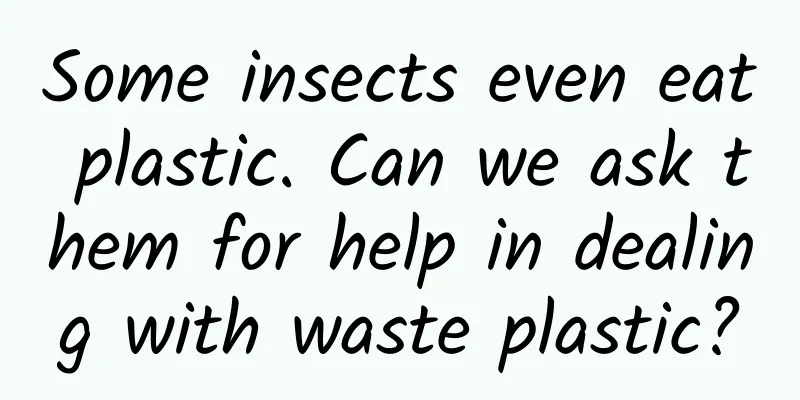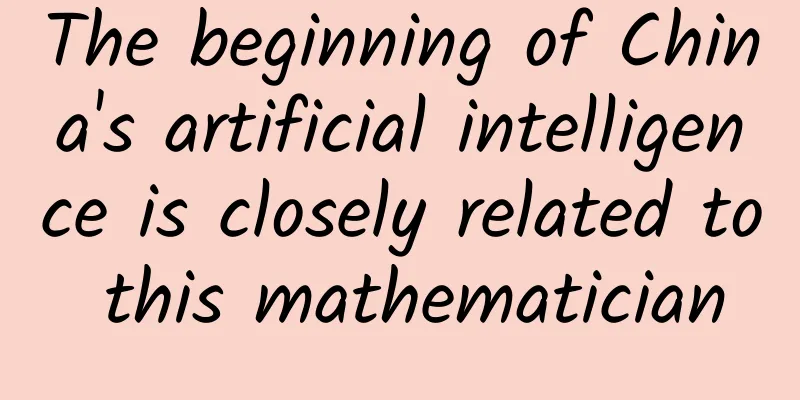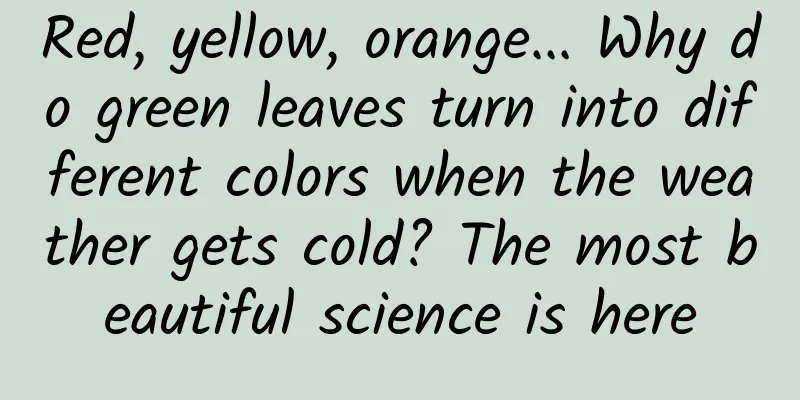Some insects even eat plastic. Can we ask them for help in dealing with waste plastic?

|
Produced by: Science Popularization China Author: Denovo Team Producer: China Science Expo Since the advent of artificial gum, global plastic production has exceeded 8.3 billion tons. However, with the widespread use of plastics, a large amount of plastic waste is discarded in landfills or the environment. Due to poor management, these wastes will decompose and release harmful chemicals, enter the food chain, and contaminate organisms at all levels. Studies have shown that microplastics with a diameter of less than 5 mm pose a potential threat to human health and ecosystems. Their accumulation may cause problems such as genetic toxicity, immune response and oxidative stress. They have been found in many parts of the human body, including the lungs, blood, and placenta. These phenomena have raised concerns that microplastics may cause inflammation, endocrine disruption and cell damage, but their specific effects still need further study. In recent years, scientists have discovered that certain insects have the potential to degrade plastics, which is expected to solve the problem of plastic pollution. The weight of plastic waste generated globally each year (Image source: Reference 2) Can plastic really be used as food for organisms? Scientists have been exploring whether plastic can be used as food by organisms. Among them, the larvae of certain beetles and moths have demonstrated the ability to feed on plastic. At present, 11 insect species have been found to be able to biodegrade plastics, mainly belonging to the Coleoptera family (Tenebrionidae) and the Lepidoptera family (Pyralidae) [3]. Among them, the most widely studied insects include mealworms (larvae of Tenebrio molitor), barleyworms (larvae of Zophobas atratus) and waxworms (larvae of Galleria mellonella). These insects can degrade a variety of common plastic materials, such as polystyrene (PS), polyethylene (PE), polyvinyl chloride (PVC), polypropylene (PP) and polyurethane (PU) [4-6]. Plastic-degrading insects from the Coleoptera Tenebriocaridae and Lepidoptera Pyralidae (Image source: Reference 3) How do insects degrade plastic? The degradation of plastic by insects is a complex biological process that can generally be divided into five different stages: the plastic is mechanically chewed by the insect's mouthparts and then enters its intestine. The insect's intestine promotes the adhesion of microorganisms. Since plastics are all high-molecular polymers, the plastic is then depolymerized by enzymes to form some oligomer fragments. These oligomer fragments are further degraded into smaller molecules. The insect's body then absorbs these small molecules and uses them as an energy source. Finally, the insect excretes the final product from its body [7]. However, the depolymerization capabilities of different insects vary. The depolymerization process of some insects depends on intestinal microorganisms. For example, the Indian meal moth (Spodoptera frugiperda) relies on intestinal Enterobacteriaceae to degrade polyethylene[8]. The waxworm’s degradation of polyethylene is not dependent on intestinal flora[9]. When researchers applied waxworm homogenate directly to the surface of polyethylene film, they found that the polyethylene suffered significant mass loss, indicating that the enzymes in the waxworm may act directly on the polyethylene surface, causing its degradation. The degradation of polypropylene and polystyrene by mealworms depends on microorganisms, but the degradation of polyethylene does not depend on microorganisms[10]. What substances are degraded by insects? Earlier studies have found that mealworms can grow normally when fed polystyrene plastic, similar to larvae fed a normal diet such as bran. The researchers analyzed the starch excreted by the larvae and confirmed that long-chain polystyrene molecules depolymerize in the larvae's intestines. The degradation capacity of insects may be limited, or the degradation process may require specific conditions or time. During the 16-day test period, 47.7% of the carbon in the ingested polystyrene molecules was converted to carbon dioxide, about 49.2% of the polystyrene residues were excreted in the form of feces, and about 0.5% of the polystyrene was assimilated into the body. This shows that mealworms have a certain ability to degrade and transform plastics, but some polystyrene is not completely decomposed, but is excreted in its original or partially decomposed form [11]. Biodegradation of polystyrene by plastic-eating mealworms (Image source: Reference 11) Other researchers discovered in accidental experiments that the larvae of the fall armyworm (Spodoptera frugiperda) can feed on polyvinyl chloride films and use these plastics to provide energy and survive for a short time. This discovery sparked scientists' interest in the mechanism of plastic degradation. Researchers isolated a bacterium that can degrade polyvinyl chloride, EMBL-1, from the intestines of this agricultural invasive insect. EMBL-1 forms a biofilm on the surface of PVC and secretes catalase-peroxidase to degrade PVC into lower molecular weight polymers. Next, the bacteria will use laccase, monooxygenase, dioxygenase, etc. to further decompose the long-chain degradation products of polyvinyl chloride and convert them into shorter products. In addition, the researchers found that genes encoding transport proteins and decomposition proteins were highly expressed in the proteome and transcriptome of the EMBL-1 strain. These genes may be involved in the transport of small organic molecules and fatty acids, indicating that the EMBL-1 strain can use the degraded polyvinyl chloride products as energy for its own growth[12]. Polyvinyl chloride degradation pathway of EMBL-1 strain (Image source: Reference 12) Will plastic that has been degraded by insects continue to pollute the environment? To determine whether degraded plastics will continue to pollute the environment, we need to understand not only how plastics are degraded, but also whether they are completely degraded and whether there are other chemical transformation products. Degradation of plastics by insects and environmental microorganisms (Image source: Reference 7) Complete degradation means that the plastic molecules are completely transformed and eventually decomposed into carbon dioxide and water. To assess whether the plastic is completely degraded, it is necessary to determine whether it has been mineralized. Mineralization is the process of complete decomposition of organic matter. During the mineralization of plastic, the carbon in the plastic is converted into carbon dioxide and incorporated into insect biomass. The degree of plastic mineralization can be indirectly assessed by measuring the amount of carbon dioxide released. If carbon dioxide is released during the degradation process, it means that part of the plastic has been converted into gas. In addition, detecting changes in carbon content and isotope ratios in insects can also help determine whether plastic carbon is integrated into organisms. Chemical transformation refers to changes in the molecular structure of plastics, but it does not necessarily mean complete degradation. As mentioned above, although some insects can degrade plastics, their degradation capacity is limited. Incompletely degraded plastics will be excreted by insects, and the environmental safety of these degradation products still needs further analysis. Industrial potential of insects degrading plastics Research on insects degrading plastics has shown its potential as an eco-friendly solution, but there are still many limitations to industrializing this process and applying it to large-scale plastic pollution control, such as: Slow degradation rate: Insects rely on digestion and microbial action to degrade plastics, a slow process that cannot cope with the growing rate of global plastic pollution. Harsh environmental conditions: The degradation efficiency is affected by environmental factors such as temperature and humidity, and specific conditions need to be maintained, which increases the complexity and cost of industrial applications. Ecological risks and operational difficulties: Different insects have different effects on the degradation of plastics, so it is necessary to accurately match the species and plastic type. At the same time, large-scale application may disrupt the ecological balance or cause species invasion. To address these limitations, scientists and companies are drawing inspiration from the mechanisms by which insects degrade plastics, and are using enzyme engineering and microbial technology to provide efficient solutions for plastic recycling. Scientists have significantly improved the efficiency of plastic degradation by optimizing the design of PET hydrolases. Studies have shown that the reaction rate, substrate specificity, and inhibitory effects of enzymes vary due to their structural differences. These studies provide important references for the development of efficient PET-degrading enzymes and enzyme screening strategies [13]. A French company has developed an enzyme-based plastic recycling process that can decompose 97% of PET plastic within 16 hours, which is 10,000 times more efficient than traditional methods. This technology can recycle different types of PET and generate food-grade recycled PET, achieving closed-loop recycling[14]. Portable, self-contained system can rapidly convert high-energy-density waste into food, water and chemicals to support expeditionary operations and stabilization missions (Image source: Reference 15) Conclusion There are many types of plastics, and the difficulty of their degradation varies depending on the polymer structure. For example, polyethylene is more difficult to degrade than polyethylene terephthalate due to its stable linear carbon skeleton. In addition, abiotic stresses such as heat, weathering, and ultraviolet rays can affect the degradation efficiency of plastics by insects and their intestinal bacteria. If matching degradation enzymes can be developed for easily degradable plastics, about half of plastic waste can be recycled. In the future, with in-depth research on degrading insects, functional bacteria, and degradation enzymes, we hope to maximize the environmental benefits of plastic recycling through technological innovation. References 1.Gibb BC (2019). Plastics are forever. Nature chemistry, 11(5), 394–395. 2.Boctor, J., Pandey, G., Xu, W., Murphy, DV, & Hoyle, FC (2024). Nature's Plastic Predators: A Comprehensive and Bibliometric Review of Plastivore Insects. Polymers, 16(12), 1671. 3.Yang, SS., Wu, WM., Bertocchini, F. et al. Radical innovation breakthroughs of biodegradation of plastics by insects: history, present and future perspectives. Front. Environ. Sci. Eng. 18, 78 (2024). 4.Peng, BY, Chen, Z., Chen, J., Yu, H., Zhou, X., Criddle, CS, Wu, WM, & Zhang, Y. (2020). Biodegradation of Polyvinyl Chloride (PVC) in Tenebrio molitor (Coleoptera: Tenebrionidae) larvae. Environment international, 145, 106106. 5. Yang, Y., Wang, J., & Xia, M. (2020). Biodegradation and mineralization of polystyrene by plastic-eating superworms Zophobas atratus. The Science of the total environment, 708, 135233. 6. Wang, Y., Luo, L., Li, X., Wang, J., Wang, H., Chen, C., Guo, H., Han, T., Zhou, A., & Zhao, total environment, 837, 155719. 7.Yang, 8. Wang, Y., Luo, L., Li, X., Wang, J., Wang, H., Chen, C., Guo, H., Han, T., Zhou, A., & Zhao, total environment, 837, 155719. 9. Bombelli, P., Howe, CJ, & Bertocchini, F. (2017). Polyethylene bio-degradation by caterpillars of the wax moth Galleria mellonella. Current biology : CB, 27(8), R292–R293. 10.Yang, L., Gao, J., Liu, Y., Zhuang, G., Peng, X., Wu, WM, & Zhuang, Chemosphere, 262, 127818. 11. Yang, Y., Yang, J., Wu, WM, Zhao, J., Song, Y., Gao, L., Yang, R., & Jiang, L. (2015). Biodegradation and Mineralization of Polystyrene by Plastic-Eating Mealworms: Part 1. Chemical and Physical Characterization and Isotopic Tests. Environmental science & technology, 49(20), 12080–12086. 12. Zhang, Z., Peng, H., Yang, D. et al. Polyvinyl chloride degradation by a bacterium isolated from the gut of insect larvae. Nat Commun 13, 5360 (2022). 13. Erickson, E., Shakespeare, TJ, Bratti, F., Buss, BL, Graham, R., Hawkins, MA, König, G., Michener, WE, Miscall, J., Ramirez, KJ, Rorrer, NA, Zahn, M., Pickford, AR, McGeehan, JE, & Beckham, GT (2022). Comparative Performance of PETase as a Function of Reaction Conditions, Substrate Properties, and Product Accumulation. ChemSusChem, 15(1), e202101932. 14. French company develops disruptive technology and launches the first 100% enzyme bio-recyclable PET bottle [EB/OL]. https://www.china-ipif.com/zh-cn/media/news02/_-100--_pet_.html 15. From Plastic to |
<<: New research: Get cold! Is it okay to be a little cold?
>>: A green alternative to plastic → breathable and waterproof paper "armor"!
Recommend
JD.com operation and promotion methods
Since I started operating JD.com , I often encoun...
The "cooked cakes" sold by Wu Dalang were not sesame cakes! But maybe... steamed buns?
Everyone knows that Wu Dalang from Qinghe County,...
National Love Teeth Day丨How far are we from dental implant freedom?
Jointly produced by: Sina News Photo and Data Roo...
An activity operation plan that can attract thousands of fans!
Article introduction: This article mainly introdu...
Zhihu information flow: a "small trend" in advertising promotion and marketing in 2019!
On the first day of 2019, Luo Zhenyu's New Ye...
International Monuments and Sites Day丨Do you know these little facts about the Great Wall?
Ancient monuments are important witnesses of the ...
A set of universal title templates to teach you how to increase article opening rates!
Whether you are writing professional and informat...
Can’t write information flow advertising copy? There is a template here, just use it!
Many friends often complain to me: " Informa...
First exposure! This star orbits a black hole in a spaghetti-like shape
Astronomers have observed a massive black hole de...
Hong Kong iPhone 6 speculator ambushed and robbed by four gangsters
The iPhone 6 craze has not subsided yet. A couple...
How does Tmall create anthropomorphic IP?
People say that the "New Year atmosphere&quo...
Is it an unnecessary "duplicate examination" to have an electrocardiogram and an echocardiogram?
People who are most concerned about annual physic...
From the golden hoop to the American team's shield, this material is indispensable
In Journey to the West, Sun Wukong's golden h...
New AI image processing method! Tsinghua team proposes a method for generating “high-resolution” images
In the hot field of "AI image generation&quo...









